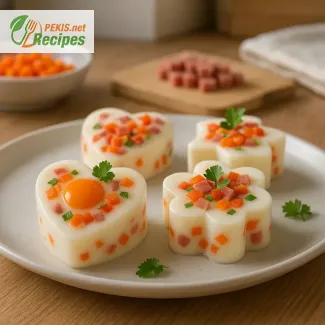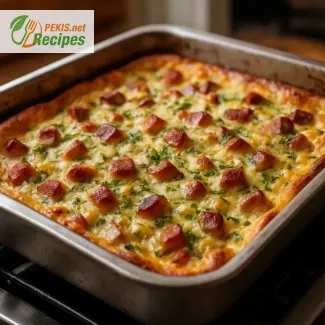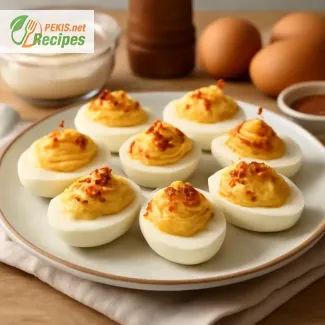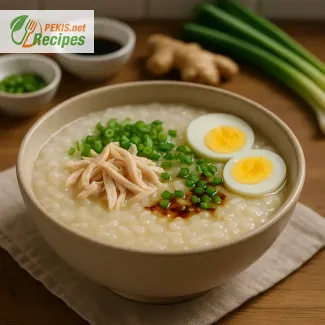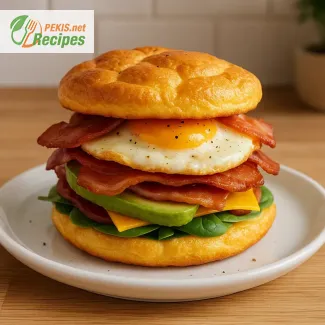
Discover the imperial charm of Austria's most iconic pancake dessert
Kaiserschmarrn as a royal indulgence in modern kitchens
There are few desserts that blend rustic simplicity and imperial elegance quite like Kaiserschmarrn, also known as the Austrian shredded pancake. Originating from the 19th-century Habsburg court, this traditional dish has transcended borders and centuries, transforming from an exclusive imperial treat to a beloved comfort food served in alpine huts, fine Viennese cafés, and modern family kitchens alike.
What sets this fluffy Kaiserschmarrn apart is not just its light, airy texture, but its story – a culinary legend wrapped in buttery batter, folded with sweet rum-soaked raisins, gently caramelized, and torn into golden, crispy bites. The name itself derives from “Kaiser” (emperor) and “Schmarrn” (a colloquial term for a scrambled or shredded dish), reinforcing its imperial origins and charmingly informal presentation.
The texture and technique behind an Austrian classic
Unlike conventional pancakes, Kaiserschmarrn is not flipped into neat rounds. It’s cooked in a single skillet, traditionally in butter, allowed to rise and develop a soft golden crust, then shredded mid-cooking into delicate pieces. The resulting dish achieves a unique balance: crispy edges, pillowy interior, and a caramelized surface kissed by powdered sugar and optional plum or apple compote.
Egg whites are beaten separately and folded into the batter, creating an unmistakably fluffy and tender structure. This step is crucial – it’s what gives Kaiserschmarrn its signature lift and cloud-like mouthfeel. The addition of dark rum-infused raisins adds complexity and fragrance, while a final dusting of sugar not only enhances the flavor but creates a beautifully rustic visual appeal.
A dish born from imperial improvisation
Legend has it that Kaiserschmarrn was born from a culinary mishap. When Emperor Franz Joseph I of Austria requested a light dessert, the royal chef's creation didn’t go as planned. The pancake tore apart in the pan, but instead of discarding it, the cook served it in shreds, glazed with sugar and enriched with raisins and jam. The emperor reportedly adored it, and the dish became a staple of Austrian court cuisine.
Today, Kaiserschmarrn still carries that imperial allure but has become accessible and beloved by food lovers around the world. Whether served as a decadent brunch, warming après-ski dessert, or family weekend treat, it resonates with people of all ages.
Why Kaiserschmarrn remains timeless and universally loved
Part of what makes Kaiserschmarrn so enduring is its versatility. It can be made with or without raisins, adapted with almond flakes, flavored with vanilla or citrus zest, and paired with a variety of toppings—from traditional Zwetschkenröster (stewed plums) to whipped cream, berries, or even a scoop of vanilla ice cream. Regardless of the variation, its fluffy texture and subtle caramelization create a deeply satisfying experience that bridges nostalgia and indulgence.
In alpine regions, Kaiserschmarrn is more than food—it's a cultural ritual. It's shared from skillet to plate, often eaten communally, evoking memories of mountain huts, snowy landscapes, and warm hospitality. The aroma of butter, sugar, and vanilla-laced batter sizzling in a pan triggers a sensory journey straight to the heart of the Austrian Alps.
An invitation to master an iconic European dessert
To recreate authentic Kaiserschmarrn, all it takes is a few humble ingredients and a little patience. The process is straightforward but rewarding, as each stage—from soaking raisins in rum to folding in stiff egg whites—contributes to a final dish that is greater than the sum of its parts. Whether you're discovering this dish for the first time or revisiting it as a family tradition, Kaiserschmarrn is a culinary expression of warmth, heritage, and simple pleasure.
With its golden surface, delicate texture, and lightly sweetened finish, this shredded pancake transcends the concept of dessert. It’s a dish that speaks of royalty and simplicity in equal measure—a rare balance that explains why it continues to enchant generations of food lovers worldwide.
The following recipe will guide you step by step through creating your own fluffy Kaiserschmarrn—a true Austrian delight that will instantly elevate your culinary repertoire.
- Soak the raisins: Place the raisins in a small bowl and pour in the dark rum. Let them soak for at least 15 minutes while preparing the batter. This enhances their flavor and aroma.
- Separate the eggs: Crack the eggs and carefully separate the yolks from the whites. Place yolks in one mixing bowl and whites in another.
- Prepare the batter: In the bowl with egg yolks, add the milk, melted butter, vanilla extract, and a pinch of salt. Whisk until smooth. Gradually add the flour while mixing continuously to avoid lumps. Set aside.
- Whip the egg whites: Using a hand mixer or stand mixer, beat the egg whites until they become frothy. Gradually add the granulated sugar and continue beating until stiff peaks form. The meringue should be glossy and firm.
- Fold in the meringue: Gently fold the egg whites into the yolk-flour batter in two batches, using a spatula. Be careful not to deflate the mixture; folding gently ensures the Kaiserschmarrn remains fluffy.
- Add raisins: Drain the rum-soaked raisins and gently fold them into the batter. Optionally, reserve a few to sprinkle during frying.
- Cook the pancake: Heat a large non-stick or cast-iron skillet over medium heat and melt the butter. Pour in the batter and spread evenly. Cover with a lid and cook for about 6–8 minutes, or until the bottom is golden and the top starts to set.
- Flip and shred: Once the bottom is golden brown, use two spatulas or forks to cut the pancake into quarters. Flip each section, then begin to tear it into bite-sized shreds. Continue cooking for another 5–7 minutes, stirring gently until all pieces are golden and slightly caramelized.
- Serve: Transfer the shredded pancake onto serving plates. Dust generously with powdered sugar. Serve warm, optionally with plum compote, apple sauce, or whipped cream.
Creative upgrades for an iconic Austrian pancake delight
Smart ways to refine and reinvent the traditional Kaiserschmarrn recipe
Perfecting a traditional dish like Kaiserschmarrn is a culinary adventure that blends respect for heritage with creativity in the kitchen. While the classic recipe yields a deliciously fluffy, golden-brown shredded pancake, several thoughtful variations and techniques can elevate this imperial treat even further. From ingredient swaps to healthier alternatives and cooking tips, there are numerous ways to make this Austrian shredded pancake uniquely your own.
Using premium ingredients to enhance flavor and texture
The quality of ingredients in Kaiserschmarrn makes a noticeable difference. Opting for organic eggs, full-fat milk, and high-quality butter adds depth and richness. Using real vanilla extract instead of synthetic flavoring introduces a natural aroma that balances the sweetness. Soaking the raisins in spiced rum, such as one infused with cinnamon or vanilla, can enhance the fruity base notes of the dish.
If you're aiming for an even fluffier pancake, try replacing part of the milk with sparkling water. This small change increases aeration in the batter and results in a lighter texture. For a more luxurious touch, a spoonful of sour cream or crème fraîche in the batter introduces a gentle tang that complements the sweetness and adds moisture.
Common mistakes and how to avoid them
Achieving the perfect Kaiserschmarrn requires attention to technique. One of the most frequent mistakes is overmixing the batter, which can collapse the whipped egg whites and result in a dense pancake. To maintain the desired airy texture, fold the egg whites gently and avoid vigorous stirring.
Another error is cooking at too high a temperature. While a crisp edge is desirable, high heat can burn the outside before the center is cooked through. Maintaining medium-low heat ensures an even golden-brown crust and soft interior.
Additionally, flipping the entire pancake like a traditional crepe can lead to breakage. Instead, allow the pancake to set undisturbed, then quarter it and gently flip the pieces before shredding. This helps retain structure while creating the signature Kaiserschmarrn bite-sized texture.
Healthier substitutions without losing authenticity
For a lighter version of Kaiserschmarrn, small adjustments can make a significant impact. Replacing some or all of the all-purpose flour with spelt flour or whole wheat flour increases fiber content while maintaining flavor integrity. Using almond milk or oat milk instead of dairy offers a lactose-free alternative that doesn’t overpower the taste.
Instead of frying in butter, opt for cold-pressed coconut oil for a mild sweetness and added antioxidants. Sweeteners like maple syrup or honey can substitute granulated sugar in the batter, giving the dish a more complex flavor profile.
If you're watching your calorie intake, reduce the amount of powdered sugar for dusting or use a fine dusting of coconut sugar, which has a lower glycemic index. Serving with fresh fruit instead of jam also lightens the overall composition while adding natural flavor.
Flavor additions and topping innovations
The classic pairing of Kaiserschmarrn with stewed plums (Zwetschkenröster) is beloved for a reason, but there are other toppings that complement its sweetness. Try serving it with a warm berry compote, vanilla bean yogurt, or a dollop of whipped ricotta. Roasted nuts like hazelnuts or slivered almonds sprinkled on top provide crunch and contrast.
In the batter itself, a pinch of grated lemon or orange zest adds freshness, while a teaspoon of ground cinnamon or cardamom can give the dish a cozy, spiced note. For a festive twist, add a splash of orange liqueur or Amaretto to the raisins during soaking.
Chocolate lovers may even fold in a handful of dark chocolate chips, which melt into pockets of indulgence without overpowering the traditional base.
Why homemade Kaiserschmarrn always tastes better
Preparing Kaiserschmarrn at home allows for full control over ingredients, texture, and presentation. Unlike pre-packaged or restaurant versions that may rely on preservatives or heavy oils, the homemade approach gives you the opportunity to craft a clean, wholesome dessert tailored to your preferences.
Moreover, Kaiserschmarrn is not just about taste—it's an experience. The process of soaking raisins, whipping egg whites, and gently tearing the pancake by hand connects you to centuries of culinary tradition. The smell of vanilla, butter, and caramelized sugar filling your kitchen adds emotional value that no store-bought version can replicate.
Serving suggestions for different occasions
While Kaiserschmarrn is often served as a dessert, it can also be enjoyed as a sweet brunch option, particularly during weekends or holidays. It pairs wonderfully with coffee, spiced tea, or even a glass of dessert wine. For an elevated presentation, dust it with powdered sugar tableside and serve on warm ceramic plates garnished with fresh herbs like lemon balm or mint.
For a playful twist at gatherings, consider a Kaiserschmarrn bar where guests can choose from various toppings—fresh fruits, sauces, nuts, and sweet spreads. This makes it a versatile crowd-pleaser adaptable to all ages and dietary needs.
Making the dish seasonally relevant
One of the joys of Kaiserschmarrn is its ability to adapt to the seasons. In summer, incorporate fresh berries or grilled peaches; in autumn, pair it with baked apples or pumpkin spice; and in winter, add cinnamon, cloves, or glühwein-poached raisins for a holiday feel. These seasonal ingredients not only bring new dimensions of flavor but also keep the dish fresh and exciting throughout the year.
Creating variations that suit your taste doesn’t detract from the authenticity of Kaiserschmarrn—it enriches it. With just a few thoughtful changes, this time-honored dessert becomes a versatile, personalized treat that continues to enchant with each new version.
Allergens present in the recipe:
- Eggs
- Milk (dairy)
- Wheat (gluten)
Substitution tips for allergens and gluten:
- Replace cow’s milk with oat or almond milk to make it dairy-free.
- Use gluten-free all-purpose flour mix (with xanthan gum) to make it suitable for gluten intolerance.
- Substitute eggs with aquafaba (3 tbsp per egg) or commercial egg replacer to avoid egg allergy.
Vitamins and minerals per serving (approximate):
- Vitamin A: 410 µg – supports healthy skin and vision
- Vitamin D: 1.1 µg – important for calcium absorption and immune health
- Vitamin B12: 0.9 µg – essential for nerve function and red blood cell production
- Calcium: 90 mg – contributes to bone strength
- Iron: 1.6 mg – supports oxygen transport and energy metabolism
- Magnesium: 22 mg – aids muscle and nerve function
- Phosphorus: 125 mg – necessary for energy production and bone health
- Zinc: 1.2 mg – enhances immune response and wound healing
Antioxidants per serving (approximate):
- Phenolic compounds from raisins: ~180 mg – help reduce oxidative stress and support heart health
- Vitamin E (from butter): ~1.2 mg – protects cells from free radical damage
- Flavonoids (from rum-soaked raisins): ~100 mg – support circulation and may lower inflammation
